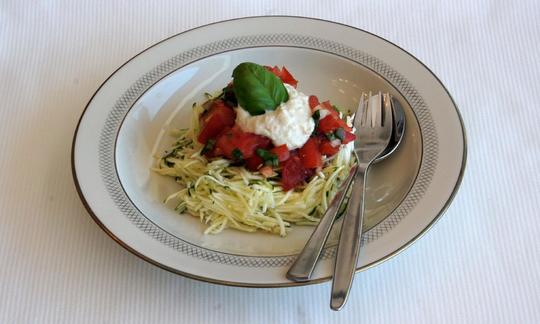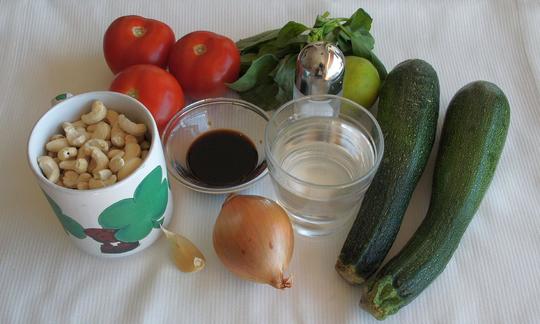Zucchini spaghetti with cashew and tomato sauce
vegan
Ingredients (for servings, )
| For the zucchini spaghetti | |
|---|---|
| 3 | Zucchini, raw, (organic?) (21 oz) |
| For the cashew sauce | |
| 2 cups | Cashew nuts, raw? organic? (cashew nuts) (9.1 oz) |
| 1 dash | Table salt (table salt, raw?, organic?) (0.01 oz) |
| 150 ml | Drinking water, raw (organic?) (5.3 oz) |
| 2 cloves | Garlic (organic?) (0.21 oz) |
| For the tomato sauce | |
| 4 | Tomatoes, raw (organic?) (17 oz) |
| 1 | Onions, raw (organic?) (3.9 oz) |
| ½ tbsp | Reduced salt soy sauce (Genen-Shoyu, organic?, raw?) (0.28 oz) |
Equipment
- hand-held blender / immersion blender or blender
- spiralizer or vegetable peeler
- garlic press
Type of preparation
- food preparation without heating
- squeeze
- season to taste
- purée
- remove the skin
- peel
Preparation
For the zucchini spaghetti
Wash the zucchini and cut it into long strips using a spiral cutter.If you don't have a spiral cutter, you can also use a vegetable peeler or a knife.
For the cashew sauce
Put the cashew nuts in a blender or puree them finely with a hand blender.Add salt and water, squeeze the garlic with the garlic press, add it and stir well.
For the tomato sauce
Wash and halve the tomatoes, cut out the stem and cut the tomatoes into small pieces.Finely chop the onion and add it to the tomatoes. Then season with tamari.
Serve
Arrange the zucchini on the plate like spaghetti. Place the sauces separately on the table or put a little of each sauce on the plate, as shown in the picture of the finished "Zucchini spaghetti with cashew and tomato sauce".
|
Nutritional Information per person
Convert per 100g
|
2000 kcal | |
|---|---|---|
| Energy | 422 kcal | 21.1% |
| Fat/Lipids | 29 g | 41.8% |
| Saturated Fats | 5.2 g | 26.2% |
| Carbohydrates (inc.dietary fiber) | 32 g | 11.9% |
| Sugars | 12 g | 13.3% |
| Fiber | 5.6 g | 22.4% |
| Protein/Albumin | 15 g | 30.5% |
| Cooking Salt (Na:130.5 mg) | 332 mg | 13.8% |
| Essential micronutrients with the highest proportions | per person | 2000 kcal | |
|---|---|---|---|
| Min | Copper, Cu | 1.6 mg | 160.0% |
| Prot | Tryptophan (Trp, W) | 0.21 g | 86.0% |
| Min | Manganese, Mn | 1.5 mg | 77.0% |
| Elem | Phosphorus, P | 481 mg | 69.0% |
| Elem | Magnesium, Mg | 233 mg | 62.0% |
| Elem | Potassium, K | 1'150 mg | 58.0% |
| Vit | Vitamin C (ascorbic acid) | 46 mg | 57.0% |
| Prot | Threonine (Thr, T, irreversibly transaminated) | 0.53 g | 57.0% |
| Fat | Linoleic acid; LA; 18:2 omega-6 | 5.2 g | 52.0% |
| Prot | Valin (Val, V) | 0.82 g | 51.0% |
Detailed Nutritional Information per Person for this Recipe
The majority of the nutritional information comes from the USDA (US Department of Agriculture). This means that the information for natural products is often incomplete or only given within broader categories, whereas in most cases products made from these have more complete information displayed.
If we take flaxseed, for example, the important essential amino acid ALA (omega-3) is only included in an overarching category whereas for flaxseed oil ALA is listed specifically. In time, we will be able to change this, but it will require a lot of work. An “i” appears behind ingredients that have been adjusted and an explanation appears when you hover over this symbol.
For Erb Muesli, the original calculations resulted in 48 % of the daily requirement of ALA — but with the correction, we see that the muesli actually covers >100 % of the necessary recommendation for the omega-3 fatty acid ALA. Our goal is to eventually be able to compare the nutritional value of our recipes with those that are used in conventional western lifestyles.
| Essential fatty acids | per person | 2000 kcal |
|---|---|---|
| Linoleic acid; LA; 18:2 omega-6 | 5.2 g | 52.0% |
| Alpha-Linolenic acid; ALA; 18:3 omega-3 | 0.14 g | 7.0% |
| Essential amino acids | per person | 2000 kcal |
|---|---|---|
| Tryptophan (Trp, W) | 0.21 g | 86.0% |
| Threonine (Thr, T, irreversibly transaminated) | 0.53 g | 57.0% |
| Valin (Val, V) | 0.82 g | 51.0% |
| Isoleucine (Ile, I) | 0.61 g | 49.0% |
| Phenylalanine (Phe, F) | 0.72 g | 47.0% |
| Leucine (Leu, L) | 1.1 g | 46.0% |
| Lysine (Lys, K, irreversibly transaminated) | 0.75 g | 40.0% |
| Methionine (Met, M) | 0.27 g | 29.0% |
| Vitamins | per person | 2000 kcal |
|---|---|---|
| Vitamin C (ascorbic acid) | 46 mg | 57.0% |
| Vitamin K | 38 µg | 51.0% |
| Vitamin B6 (pyridoxine) | 0.66 mg | 47.0% |
| Vitamin B9, B11 (Folate, as the active form of folic acid) | 75 µg | 38.0% |
| Vitamin B1 (Thiamine) | 0.40 mg | 37.0% |
| Vitamin B7 (Biotin, ex vitamin H) | 13 µg | 27.0% |
| Vitamin B5 (Pantothenic acid) | 1.0 mg | 17.0% |
| Vitamin B2 (Riboflavin) | 0.21 mg | 15.0% |
| Vitamin B3 (Niacin) | 2.1 mg | 13.0% |
| Vitamin E, as a-TEs | 1.4 mg | 12.0% |
| Vitamin A, as RAE | 66 µg | 8.0% |
| Essential macroelements (macronutrients) | per person | 2000 kcal |
|---|---|---|
| Phosphorus, P | 481 mg | 69.0% |
| Magnesium, Mg | 233 mg | 62.0% |
| Potassium, K | 1'150 mg | 58.0% |
| Sodium, Na | 131 mg | 16.0% |
| Calcium, Ca | 70 mg | 9.0% |
| Essential trace elements (micronutrients) | per person | 2000 kcal |
|---|---|---|
| Copper, Cu | 1.6 mg | 160.0% |
| Manganese, Mn | 1.5 mg | 77.0% |
| Zinc, Zn | 4.5 mg | 45.0% |
| Iron, Fe | 5.3 mg | 38.0% |
| Selenium, Se | 14 µg | 25.0% |
| Iod, I (Jod, J) | 5.1 µg | 3.0% |
| Fluorine, F | 31 µg | 1.0% |
Zucchini spaghetti with cashew and tomato sauce is a successful pasta alternative that stimulates the appetite with a flavorful combination of sauces.
Zucchini: Bitter-tasting zucchini should not be eaten. Bitter spots can be a sign that the zucchini contains poisonous bitter substances that attack the stomach and intestinal mucosa. When growing your own zucchini, you should also be aware that backcrossing home-grown seeds or crossing them with other pumpkin plants can result in an increased content of poisonous bitter substances.
Tamari: Tamari is a mildly spicy soy sauce. It is used to refine and season dishes. Tamari is made from soybeans, water and sea salt. Unlike Shōyu soy sauce, Tamari does not contain rice or wheat.
We do not consider soy sauce to be a raw food. During the manufacturing process, soybeans are usually heated because green beans of all kinds contain the glycoprotein phasin, which is toxic to humans. Phasin impairs the absorption of nutrients in the intestine, has a hemagglutinating effect (causes red blood cells to clump together) and can also destroy the intestinal villi in high doses. Heating processes (cooking, roasting, etc.) destroy phasin and thus make soybeans and products made from them such as tofu, miso or tempeh edible for humans. This means that even unpasteurized soy products are no longer actually raw food, but merely cooked food that has been "revived" through fermentation.
Cashews are rarely raw food: Cashew nuts or cashew kernels have practically always been heated, even if the packaging says "raw cashew kernels", which usually only indicates that the toxic cardol was deactivated using steam rather than a roasting process. We can only assume that the product is raw food if the process is explained in detail and checked.
Optimal storage of tomatoes: Tomatoes are best stored at 13 to 18 °C and at a relative humidity of 80 to 95%. Under good storage conditions, tomatoes can be kept for up to 14 days. Storing them in the refrigerator is definitely not recommended, as this not only reduces the production of volatile aromas, but also reduces their content in the fruit after a few days.
Storing soy sauce: Unlike tomatoes, storing it in the fridge is useful here. An opened bottle of soy sauce will last up to six months if you store it in the fridge. If you keep the soy sauce on the kitchen shelf, it won't spoil any faster, but it will lose color and flavor.
Spiral cutter: The spiral cutter is ideal for cutting vegetables into fine spaghetti-shaped strips. If you don't have a spiral cutter, you can also use a vegetable peeler or a knife.
Change the cashew sauce: Depending on your taste, you can use Brazil nuts or macadamia nuts instead of cashews.
Expanding the tomato sauce: You can add other vegetables to the tomato sauce as you like. Peppers taste very good as a vegetable in combination with zucchini and tomatoes. Eggplants also go well with tomatoes.
Alternative to soy sauce: If you don't like soy sauce or are allergic to soy, you can use herbs for seasoning or vegetable stock instead.






